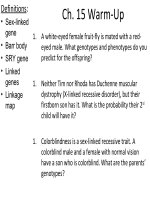Lecture Undergraduate econometrics - Chapter 15: Distributed lag models
Bạn đang xem bản rút gọn của tài liệu. Xem và tải ngay bản đầy đủ của tài liệu tại đây (115.2 KB, 43 trang )
Chapter 15
Distributed Lag Models
15.1
Introduction
• In this chapter we focus on the dynamic nature of the economy, and the corresponding
dynamic characteristics of economic data.
• We recognize that a change in the level of an explanatory variable may have
behavioral implications beyond the time period in which it occurred.
The
consequences of economic decisions that result in changes in economic variables can
last a long time.
• When the income tax is increased, consumers have less disposable income, reducing
their expenditures on goods and services, which reduces profits of suppliers, which
Slide 15.1
Undergraduate Econometrics, 2nd Edition-Chapter 15
reduces the demand for productive inputs, which reduces the profits of the input
suppliers, and so on.
• These effects do not occur instantaneously but are spread, or distributed, over future
time periods. As shown in Figure 15.1, economic actions or decisions taken at one
point in time, t, affect the economy at time t, but also at times t + 1, t + 2, and so on.
• Monetary and fiscal policy changes, for example, may take six to eight months to have
a noticeable effect; then it may take twelve to eighteen months for the policy effects to
work through the economy.
• Algebraically, we can represent this lag effect by saying that a change in a policy
variable xt has an effect upon economic outcomes yt, yt+1, yt+2, … . If we turn this
around slightly, then we can say that yt is affected by the values of xt, xt-1, xt-2, … , or
yt = f(xt, xt-1, xt-2,…)
(15.1.1)
Slide 15.2
Undergraduate Econometrics, 2nd Edition-Chapter 15
• To make policy changes policymakers must be concerned with the timing of the
changes and the length of time it takes for the major effects to take place. To make
policy, they must know how much of the policy change will take place at the time of
the change, how much will take place one month after the change, how much will take
place two months after the changes, and so on.
• Models like (15.1.1) are said to be dynamic since they describe the evolving economy
and its reactions over time.
• One immediate question with models like (15.1.1) is how far back in time we must go,
or the length of the distributed lag. Infinite distributed lag models portray the effects
as lasting, essentially, forever. In finite distributed lag models we assume that the
effect of a change in a (policy) variable xt affects economic outcomes yt only for a
certain, fixed, period of time.
Slide 15.3
Undergraduate Econometrics, 2nd Edition-Chapter 15
15.2
Finite Distributed Lag Models
15.2.1 An Economic Model
• Quarterly capital expenditures by manufacturing firms arise from appropriations
decisions in prior periods. Once an investment project is decided on, funds for it are
appropriated, or approved for expenditure. The actual expenditures arising from any
appropriation decision are observed over subsequent quarters as plans are finalized,
materials and labor are engaged in the project, and construction is carried out.
• If xt is the amount of capital appropriations observed at a particular time, we can be
sure that the effects of that decision, in the form of capital expenditures yt, will be
“distributed” over periods t, t + 1, t + 2, and so on until the projects are completed.
• Furthermore, since a certain amount of “start-up” time is required for any investment
project, we would not be surprised to see the major effects of the appropriation
decision delayed for several quarters.
Slide 15.4
Undergraduate Econometrics, 2nd Edition-Chapter 15
• As the work on the investment projects draws to a close, we expect to observe the
expenditures related to the appropriation xt declining.
• Since capital appropriations at time t, xt, affect capital expenditures in the current and
future periods (yt, yt+1, yt+2, …), until the appropriated projects are completed, we may
say equivalently that current expenditures yt are a function of current and past
appropriations xt, xt-1, … .
• Furthermore, let us assert that after n quarters, where n is the lag length, the effect of
any appropriation decision on capital expenditure is exhausted. We can represent this
economic model as
yt = f(xt, xt-1, xt-2, … , xt-n)
(15.2.1)
• Current capital expenditures yt depend on current capital appropriations, xt, as well as
the appropriations in the previous n periods, xt, xt-1, xt-2, … , xt-n. This distributed lag
Slide 15.5
Undergraduate Econometrics, 2nd Edition-Chapter 15
model is finite as the duration of the effects is a finite period of time, namely n
periods. We now must convert this economic model into a statistical one so that we
can give it empirical content.
15.2.2 The Econometric Model
• In order to convert model (15.2.1) into an econometric model we must choose a
functional form, add an error term and make assumptions about the properties of the
error term.
• As a first approximation let us assume that the functional form is linear, so that the
finite lag model, with an additive error term, is
yt = α + β0xt + β1xt-1 + β2xt-2 + … + βnxt-n + et, t = n + 1, … , T
(15.2.2)
Slide 15.6
Undergraduate Econometrics, 2nd Edition-Chapter 15
where we assume that E(et) = 0, var(et) = σ2, and cov(et, es) = 0.
• Note that if we have T observations on the pairs (yt, xt) then only T − n complete
observations are available for estimation since n observations are “lost” in creating xt-1,
xt-2, … , xt-n.
• In this finite distributed lag the parameter α is the intercept and the parameter βi is
called a distributed lag weight to reflect the fact that it measures the effect of changes
in past appropriations, ∆xt-i, on expected current expenditures, ∆E(yt), all other things
held constant. That is,
∂E ( yt )
= βi
∂xt −i
(15.2.3)
• Equation (15.2.2) can be estimated by least squares if the error term et has the usual
desirable properties. However, collinearity is often a serious problem in such models.
Slide 15.7
Undergraduate Econometrics, 2nd Edition-Chapter 15
Recall from Chapter 8 that collinearity is often a serious problem caused by
explanatory variables that are correlated with one another.
• In Equation (15.2.2) the variables xt and xt-1, and other pairs of lagged x’s as well, are
likely to be closely related when using time-series data. If xt follows a pattern over
time, then xt-1 will follow a similar pattern, thus causing xt and xt-1 to be correlated.
There may be serious consequences from applying least squares to these data.
• Some of these consequences are imprecise least squares estimation, leading to wide
interval estimates, coefficients that are statistically insignificant, estimated coefficients
that may have incorrect signs, and results that are very sensitive to changes in model
specification or the sample period. These consequences mean that the least squares
estimates may be unreliable.
• Since the pattern of lag weights will often be used for policy analysis, this imprecision
may have adverse social consequences. Imposing a tax cut at the wrong time in the
business cycle can do much harm.
Slide 15.8
Undergraduate Econometrics, 2nd Edition-Chapter 15
15.2.3 An Empirical Illustration
• To give an empirical illustration of this type of model, consider data on quarterly
capital expenditures and appropriations for U. S. manufacturing firms. Some of the
observations are shown in Table 15.1.
• We assume that n = 8 periods are required to exhaust the expenditure effects of a
capital appropriation in manufacturing. The basis for this choice is investigated in
Section 15.2.5, since the lag length n is actually an unknown constant. The least
squares parameter estimates for the finite lag model (15.2.2) are given in Table 15.2.
Table 15.2
Least Squares Estimates for the Unrestricted Finite
Distributed Lag Model
Variable
Estimate
Std. Error
t-value
p-value
const.
3.414
53.709
0.622
0.5359
Slide 15.9
Undergraduate Econometrics, 2nd Edition-Chapter 15
xt
0.038
0.035
1.107
0.2721
xt −1
0.067
0.069
0.981
0.3300
xt − 2
0.181
0.089
2.028
0.0463
xt −3
0.194
0.093
2.101
0.0392
xt − 4
0.170
0.093
1.824
0.0723
xt −5
0.052
0.092
0.571
0.5701
xt −6
0.052
0.094
0.559
0.5780
xt −7
0.056
0.094
0.597
0.5526
xt −8
0.127
0.060
2.124
0.0372
• The R2 for the estimated relation is 0.99 and the overall F-test value is 1174.8. The
statistical model “fits” the data well and the F-test of the joint hypotheses that all
distributed lag weights βi = 0, i = 0, ... , 8, is rejected at the α = .01 level of
significance.
Slide 15.10
Undergraduate Econometrics, 2nd Edition-Chapter 15
• Examining the individual parameter estimates, we notice several disquieting facts.
First, only the lag weights b2, b3, b4, and b8 are statistically significantly different from
zero based on individual t-tests, reflecting the fact that the estimates’ standard errors
are large relative to the estimated coefficients.
• Second, the estimated lag weights b7 and b8 are larger than the estimated lag weights
for lags of 5 and 6 periods. This does not agree with our anticipation that the lag
effects of appropriations should decrease with time and in the most distant periods
should be small and approaching zero.
• These characteristics are symptomatic of collinearity in the data.
The simple
correlations among the current and lagged values of capital appropriations are large.
Consequently, a high level of linear dependence is indicated among the explanatory
variables. Thus, we conclude that the least squares estimates in Table 15.2 are subject
to great sampling variability and are unreliable, owing to the limited independent
information provided by each explanatory variable xt-i.
Slide 15.11
Undergraduate Econometrics, 2nd Edition-Chapter 15
• In Chapter 8 we noted that one way to combat the ill-effects of collinearity is to use
restricted least squares. By replacing restrictions on the model parameters we reduce
the variances of the estimator.
• In the context of distributed lag models we often have an idea of the pattern of the
time effects, which we can translate into parameter restrictions. In the following
section we restrict the lag weights to fall on a polynomial.
15.2.4 Polynomial Distributed Lags
• Imposing a shape on the lag distribution will reduce the effects of collinearity. Let us
assume that the lag weights follow a smooth pattern that can be represented by a low
degree polynomial. Shirley Almon introduced this idea, and the resulting finite lag
model is often called the Almon distributed lag, or a polynomial distributed lag.
Slide 15.12
Undergraduate Econometrics, 2nd Edition-Chapter 15
• For example, suppose we select a second-order polynomial to represent the pattern of
lag weights. Then the effect of a change in xt-i on E(yt) is
∂E ( yt )
= βi = γ 0 + γ1i + γ 2i 2 , i = 0, K , n
∂xt −i
(15.2.4)
• An example of this quadratic polynomial lag is depicted in Figure 15.2.
The
polynomial lag in Figure 15.2 depicts a situation that commonly arises when modeling
the effects of monetary and fiscal policy. At time t the effect of a change in a policy
variable is
∂E ( yt )
= β0 = γ 0
∂xt
Slide 15.13
Undergraduate Econometrics, 2nd Edition-Chapter 15
The immediate impact might well be less than the impact after several quarters, or
months. After reaching its maximum, the policy effect diminishes for the remainder
of the finite lag.
• For illustrative purposes again suppose that the lag length is n = 4 periods. Then the
finite lag model is
yt = α + β0xt + β1xt-1 + β2xt-2 + β3xt-3 + β4xt-4 + et, t = 5, … , T
(15.2.5)
• Then the relations in Equation (15.2.4) become
β0 = γ0
i=0
β1 = γ0 + γ1 + γ2
i=1
β2 = γ0 + 2γ1 + 4γ2
i=2
β3 = γ0 + 3γ1 + 9γ2
i=3
(16.2.6)
Slide 15.14
Undergraduate Econometrics, 2nd Edition-Chapter 15
β4 = γ0 + 4γ1 + 16γ2
i=4
• In order to estimate the parameters describing the polynomial lag, γ0, γ1, and γ2, we
substitute Equation (15.2.6) into the finite lag model Equation (15.2.5) to obtain
yt = α + γ0xt + (γ0 + γ1 + γ2)xt-1 + (γ0 + 2γ1 + 4γ2)xt-2
+ (γ0 + 3γ1 + 9γ2)xt-3 + (γ0 + 4γ1 + 16γ2)xt-4 + et
= α + γ0zt0 + γ1zt1 + γ2zt2 + et
(15.2.7)
In Equation (15.2.7) we have defined the constructed variables ztk as
zt0 = xt + xt-1 + xt-2 + xt-3 + xt-4
zt1 = xt-1 + 2xt-2 + 3xt-3 + 4xt-4
zt2 = xt-1 + 4xt-2 + 9xt-3 + 16xt-4
Slide 15.15
Undergraduate Econometrics, 2nd Edition-Chapter 15
• Once these variables are created the polynomial coefficients are estimated by applying
least squares to Equation (15.2.7).
• If we denote the estimated values of γk by γˆ k , then we can obtain the estimated lag
weights as
βˆ i = γ?0 + γ1i + γ 2i 2 , i = 0, K , n
(15.2.8)
Whatever the degree of the polynomial, the general procedure is an extension of what
we have described for the quadratic polynomial.
• Equation (15.2.7) is a restricted model. We have replaced (n + 1) = 5 distributed lag
weights with 3 polynomial coefficients.
This implies that in constraining the
distributed lag weights to a polynomial of degree 2 we have imposed J = (n + 1) − 3 =
2 parameter restrictions.
Slide 15.16
Undergraduate Econometrics, 2nd Edition-Chapter 15
• We may wish to check the compatibility of the quadratic polynomial lag model with
the data by performing an F-test, comparing the sum of squared errors from the
restricted model in Equation (15.2.7) to the sum of squared errors from the
unrestricted model (15.2.5).
• As an illustration, we will fit a second-order polynomial lag to the capital expenditure
data in Table 15.1, with a lag length of n = 8 periods. In Table 15.3 are the estimated
polynomial coefficients from Equation (15.2.7).
Table 15.3
Estimated (Almon) Polynomial
Coefficients
Parameter
Estimates
t-value
p-value
α
51.573
0.970
0.3351
γ0
0.067
4.411
0.0001
γ1
0.038
2.984
0.0038
Slide 15.17
Undergraduate Econometrics, 2nd Edition-Chapter 15
γ2
−0.005
−3.156
0.0023
• In Table 15.4 we present the distributed lag weights calculated using Equation (15.2.8).
The reported standard errors are based on the fact that the estimated distributed lag
weights are combinations of the estimates in Table 15.3.
Table 15.4 Estimated Almon Distributed Lag Weights from
Polynomial of Degree Two
Parameter
Estimate
Std. Error
t-value
p-value
β0
0.067
0.015
4.41
0.0001
β1
0.100
0.005
19.60
0.0001
β2
0.123
0.005
22.74
0.0001
β3
0.136
0.009
14.40
0.0001
β4
0.138
0.011
12.86
0.0001
Slide 15.18
Undergraduate Econometrics, 2nd Edition-Chapter 15
β5
0.130
0.009
14.31
0.0001
β6
0.112
0.005
20.92
0.0001
β7
0.083
0.007
11.32
0.0001
β8
0.044
0.018
2.47
0.0156
• Since the estimated weights in Table 15.4 are linear combinations of the estimated
polynomial coefficients in Table 15.3, as shown in Equation (15.2.8), their estimated
variances are calculated using Equation (2.5.8), from Chapter 2.
• Constraining the distributed lag weights to fall on a polynomial of degree two has
drastically affected their values as compared to the unconstrained values in Table 15.2.
• Also, note that the standard errors of the estimated coefficients are much smaller than
those in the unconstrained model indicating more precise parameter estimation.
Slide 15.19
Undergraduate Econometrics, 2nd Edition-Chapter 15
Remark: Recall that imposing restrictions on parameters leads to bias unless
the restrictions are true.
In this case we do not really believe that the
distributed lag weights fall exactly on a polynomial of degree two. However, if
this assumption approximates reality, then the constrained estimator will
exhibit a small amount of bias. Our objective is to trade a large reduction in
sampling variance for the introduction of some bias, increasing the probability
of obtaining estimates close to the true values.
• In Figure 15.3 we plot the unrestricted estimates of lag weights and the restricted
estimates. Note that the restricted estimates display the increasing-then-decreasing
“humped” shape that economic reasoning led us to expect. The effect of a change in
capital appropriations xt at time t leads to an increase in capital expenditures in the
current period, yt, by a relatively small amount. However, the expenditures arising
Slide 15.20
Undergraduate Econometrics, 2nd Edition-Chapter 15
from the appropriation decision increase during the next four quarters, before the
effect begins to taper off.
15.2.5 Selection of the Length of the Finite Lag
• Numerous procedures have been suggested for selecting the length n of a finite
distributed lag. None of the proposed methods is entirely satisfactory. The issue is an
important one, however, because fitting a polynomial lag model in which the lag
length is either over- or understated may lead to biases in the estimation of the lag
weights, even if an appropriate polynomial degree has been selected.
• We offer two suggestions that are based on “goodness-of-fit” criteria. Begin by
selecting a lag length N that is the maximum that you are willing to consider. The
unrestricted finite lag model is then
Slide 15.21
Undergraduate Econometrics, 2nd Edition-Chapter 15
yt = α + β0xt + β1xt-1 + β2xt-2 + β3xt-3 + … + βNxt-N + et
(15.2.9)
• We wish to assess the goodness of fit for lag lengths n ≤ N. The usual measures of
goodness-of-fit, R2 and R 2 , have been found not to be useful for this task.
• Two goodness-of-fit measures that are more appropriate are Akaike’s AIC criterion
SSEn 2(n + 2)
+
T−N
T−N
(15.2.10)
SSEn ( N + 2)ln(T − N )
+
T −N
T −N
(15.2.11)
AIC = ln
and Schwarz’s SC criterion
SC = ln
Slide 15.22
Undergraduate Econometrics, 2nd Edition-Chapter 15
• For each of these measures we seek that lag length n* that minimizes the criterion
used. Since adding more lagged variables reduces SSE, the second part of each of the
criteria is a penalty function for adding additional lags.
• These measures weigh reductions in sum of squared errors obtained by adding
additional lags against the penalty imposed by each. They are useful for comparing
lag lengths of alternative models estimated using the same number of observations.
Slide 15.23
Undergraduate Econometrics, 2nd Edition-Chapter 15
15.3
The Geometric Lag
An infinite distributed lag model in its most general form is:
yt = α + β0 xt + β1 xt −1 + β2 xt − 2 + β3 xt −3 + L + et
(15.3.1)
∞
= α + ∑ βi xt −i + et
i =0
• In this model yt is taken to be a function of xt and all its previous values. There may
also be other explanatory variables on the right-hand side of the equation. The model
in Equation (15.3.1) is impossible to estimate since there are an infinite number of
parameters.
• Models have been developed that are parsimonious, and which reduce the number of
parameters to estimate. The cost of reducing the number of parameters is that these
Slide 15.24
Undergraduate Econometrics, 2nd Edition-Chapter 15
models must assume particular patterns for the parameters βi, which are called
distributed lag weights.
• One popular model is the geometric lag, in which the lag weights are positive and
decline geometrically. That is
βi = βφi, |φ| < 1
(15.3.2)
The parameter β is a scaling factor and the parameter φ is less than 1 in absolute value.
The pattern of lag weights βi is shown in Figure 15.4.
• The lag weights βi = βφi decline toward zero as i gets larger. The most recent past is
more heavily weighted than the more distant past, and, although the weights never
reach zero, beyond a point they become negligible.
• Substituting Equation (15.3.2) into Equation (15.3.1) we obtain,
Slide 15.25
Undergraduate Econometrics, 2nd Edition-Chapter 15









